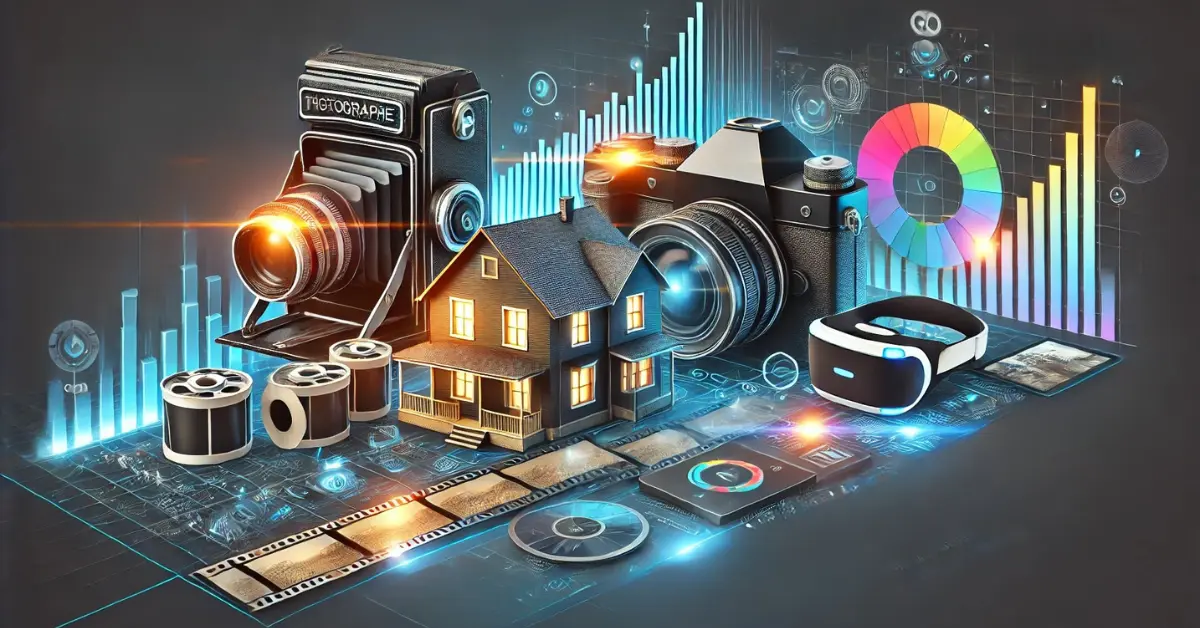The world of real estate has always been driven by visual appeal. For decades, real estate photography has played a pivotal role in how properties are marketed and sold. As technology has advanced, so has the art of capturing properties in the most attractive and engaging ways. From the early days of film photography to the dynamic realm of virtual tours, the evolution of real estate photography reflects a broader shift in how buyers engage with properties.
In this comprehensive guide, we’ll explore how real estate photography has transformed over time, the technological innovations that have shaped it, and how these changes have revolutionized property marketing.
Table of Contents
ToggleThe Era of Film Photography in Real Estate
Early Beginnings
Before the digital revolution, real estate agents and property developers relied on film photography to showcase properties. The process was labor-intensive and costly, requiring skilled photographers to capture images that would later be developed in darkrooms.
- Equipment: Large, bulky cameras and film rolls
- Processing Time: Long development and printing times
- Distribution: Physical photos in brochures, newspapers, and magazines
Limitations of Film Photography
Film photography had significant limitations in real estate marketing:
- Limited Shots: Film rolls had a limited number of exposures.
- No Instant Feedback: Photographers couldn’t review images on-site.
- Costly Production: Printing and distributing physical images was expensive.
- Static Presentation: Buyers had limited ways to engage with listings beyond photos.
Despite these challenges, film photography was the gold standard for property marketing until digital technology emerged.
The Digital Photography Revolution
Transition to Digital Photography
The late 1990s and early 2000s saw the introduction of digital cameras, revolutionizing real estate photography. High-resolution digital images allowed agents to present properties more effectively and efficiently.
Key Advancements:
- Instant Image Review: Photographers could preview shots immediately.
- Unlimited Shots: No more film limits allowed for more creativity.
- Editing Capabilities: Digital photos could be enhanced with editing software.
- Faster Turnaround: Images could be uploaded and shared online instantly.
Rise of Online Listings
As digital photography improved, real estate marketing shifted online. Websites like Realtor.com and Zillow gained popularity, making it essential for agents to upload high-quality property images.
Impact on Marketing:
- Global Reach: Properties could be viewed by potential buyers worldwide.
- Cost Efficiency: No printing costs and faster distribution.
- Visual Storytelling: More photos and diverse angles improved storytelling.
The Role of Editing Software
Photo editing software like Adobe Photoshop and Lightroom became essential tools for photographers. They allowed professionals to enhance lighting, correct colors, and even stage homes virtually.
Common Editing Techniques:
- Brightness and contrast adjustments
- Color correction
- Sky replacement for exteriors
- Minor retouching and object removal
Digital photography set the stage for the next wave of innovation—immersive experiences.
The Emergence of High Dynamic Range (HDR) Photography
What is HDR Photography?
HDR photography blends multiple exposures of the same scene to capture a greater range of light and detail. This technique became especially popular in real estate to produce vibrant, true-to-life images.
Benefits for Real Estate:
- Balanced lighting in bright and dark areas
- Enhanced colors and textures
- More realistic representation of spaces
Impact on Property Marketing
HDR photography enabled agents to present properties more authentically, especially for homes with complex lighting or stunning views. This technique helped bridge the gap between how a property looked in photos and in person.
Drone Photography and Aerial Imaging
Introduction of Drone Technology
The adoption of drones in real estate photography brought a revolutionary perspective to property marketing. Drones allowed for breathtaking aerial shots, providing context to a property’s surroundings.
Applications in Real Estate:
- Showcasing large estates and land
- Highlighting nearby amenities and landscapes
- Emphasizing curb appeal and outdoor features
Regulatory Considerations
With drone usage came legal considerations, including licensing and airspace regulations. Professional photographers needed to comply with local aviation rules to operate drones legally.
The Impact on Luxury Real Estate
High-end properties greatly benefited from aerial photography. It became a standard marketing tool for luxury homes, golf courses, resorts, and commercial real estate developments.
Discover the latest preconstruction homes in Markham, Ontario and explore exclusive opportunities to secure your dream home at unbeatable prices.
The Age of 3D Imaging and Virtual Tours
The Rise of Virtual Tours
One of the most significant advancements in real estate photography has been the rise of 3D imaging and virtual tours. Technologies like Matterport and 360-degree cameras allow buyers to explore properties remotely.
Key Features:
- Interactive 3D walkthroughs
- 360-degree panoramic views
- Dollhouse and floor plan views
Benefits for Buyers and Sellers
For Buyers:
- Tour properties without leaving home
- Gain a better sense of space and layout
- Save time by narrowing down options
For Sellers:
- Broader market reach
- Competitive advantage in listings
- Increased engagement and interest
The COVID-19 Influence
The COVID-19 pandemic accelerated the adoption of virtual tours as in-person showings became limited. Virtual tours provided a safe and effective way to market properties during lockdowns.
Stay updated with expert insights and news on preconstruction projects in Ontario by visiting this comprehensive blog.
Augmented Reality (AR) and Virtual Staging
Virtual Staging
Virtual staging uses digital technology to furnish and decorate empty properties. This is a cost-effective alternative to traditional staging and allows for multiple design styles.
Browse the most recent Markham real estate listings to find your perfect property in this thriving Ontario community.
Advantages:
- Lower cost than physical staging
- Flexibility to appeal to different tastes
- Faster property preparation
Augmented Reality (AR)
AR allows potential buyers to visualize how a property could look with their personal touches. Using apps, buyers can place virtual furniture and décor into a space through their smartphones.
Impact on Sales:
- Increases buyer engagement
- Helps buyers personalize a space
- Provides a futuristic and interactive experience
The Future of Real Estate Photography
Artificial Intelligence (AI) Integration
AI is poised to revolutionize real estate photography by automating photo editing and property analysis. AI-driven tools can enhance images, generate virtual tours, and even predict buyer preferences.
Explore market trends and tips for buying or selling property in Markham by visiting the ultimate Markham real estate blog.
Interactive and Immersive Media
Future trends may include fully immersive virtual reality (VR) experiences, allowing buyers to walk through properties using VR headsets, and holographic displays for property presentations.
Sustainability and Eco-Friendly Marketing
Drones and virtual tours reduce the need for physical visits, lowering carbon footprints. Digital marketing strategies align with growing sustainability initiatives in real estate.
Conclusion – Evolution of Real Estate Photography
The evolution of real estate photography has dramatically changed how properties are marketed and sold. From the early days of film to the digital revolution and now into the era of virtual tours and augmented reality, each advancement has made it easier to showcase properties in compelling ways.
Enhance your property listings with stunning visuals by partnering with real estate photography experts in Markham at Click Media Pro.
As technology continues to evolve, real estate photography will become even more interactive, immersive, and efficient. Whether you’re a real estate agent, a property developer, or a buyer, staying ahead of these trends is essential in today’s competitive market. The future of real estate marketing is visual, digital, and limitless.

